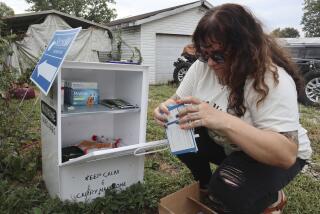NYPD to try GPS in ‘bait bottles’ to track drug thieves
New York police plan to distribute “bait bottles” of fake pain-killers equipped with invisible GPS devices in a drive to combat the scourge of pharmacy robberies by addicts and sellers looking for oxycodone tablets, which can fetch more than $80 per pill on the street.
New York Police Commissioner Raymond Kelly announced the novel approach at the 2013 Clinton Health Matters Conference in La Quinta on Tuesday, saying his city’s cases of oxycodone-related crime have included a retired police officer who resorted to robbing pharmacies to satisfy his craving for the highly addictive narcotic.
“In the event of a robbery or theft, we’ll be able to track the bottle which may lead us to stash locations across the city,” Kelly said in prepared remarks to the conference.
Eventually, the tracking effort could expand to include actual placebo tablets being fitted with tracking devices, police say.
The fitting of tracking devices on bottles filled with placebos is the latest effort to combat a problem that the Drug Enforcement Administration says is getting worse and fueling a market for other cheaper drugs, including heroin, which have effects similar to those of the prescription painkillers.
According to the National Institute on Drug Abuse, accidental overdose deaths from prescription pain-relievers have quadrupled since 1999. Their increased use has also led to a jump in holdups of pharmacies. The DEA says armed robberies of drug stores increased 79% between 2006 and 2010.
One pharmacy holdup in April in Manhattan led to shooting on a busy street in Harlem when an armed robber fired at police responding to the store clerk’s pressing of a panic button. An off-duty police officer who happened to be at a gas station nearby shot the robber dead as he tried to flee. Kelly said the robber was suspected of holding up other pharmacies in the city.
On Long Island, east of New York City, four people were shot to death last year in a neighborhood drug store by a gunman who prosecutors say was trying to steal prescription painkillers to feed his wife’s addiction. Earlier in the year, also on Long Island, a man was shot to death at a drug store where he had gone to pick up cancer medicine for his father. The alleged gunman, who was in turn shot to death by police, was carrying stolen painkillers.
“The NYPD has seen firsthand the destructive power of addiction to Oxycontin,” Kelly said. “One of our own retired police officers who became addicted to the pills after incurring an injury on the job began robbing drug stores at gunpoint.”
The “bait bottle” is one of several plans outlined by Kelly, who said the Police Department also has established a “drug diversion task force” to work with the DEA; expanded an education campaign at city schools that includes creating a “lesson plan” about prescription drug abuse; and enhanced training of new recruits so they can better recognize various medications.
Police also are building a database of the nearly 6,000 licensed pharmacists in New York City, some of which will receive the “bait bottles” containing placebo pills to be placed on their shelves. The database is expected to be completed in March. The police spokesman, Deputy Commissioner Paul Browne, compared it to placing cash equipped with exploding dye in banks to trip up bank robbers.
“Instead of anything exploding, a GPS signal would be sent off and we’d know where that person is,” he said. As for the idea of taking the idea a step further by fitting actual placebos with tracking devices, Kelly says the Police Department has asked researchers to explore the possibility.
The health conference is an annual event organized by former President Clinton’s Clinton Foundation.
ALSO:
Why did FBI militia informant have a foot in Alaska politics?
Reddit cofounder Swartz struggled with prosecution before suicide
Sandy Hook group calls for ‘real change,’ but what does that mean?
More to Read
Sign up for Essential California
The most important California stories and recommendations in your inbox every morning.
You may occasionally receive promotional content from the Los Angeles Times.











